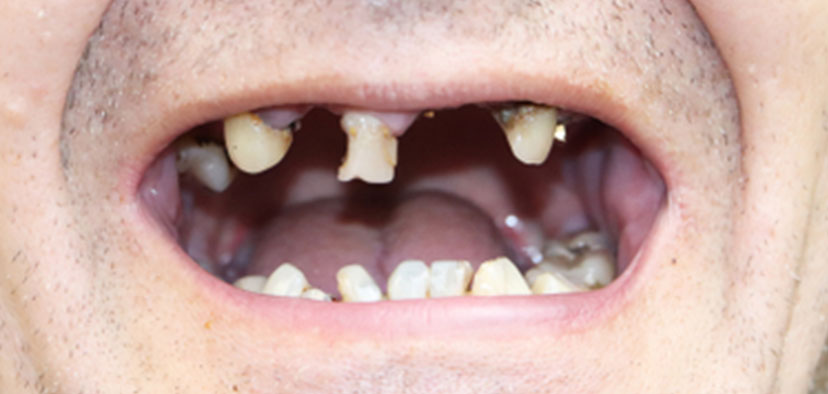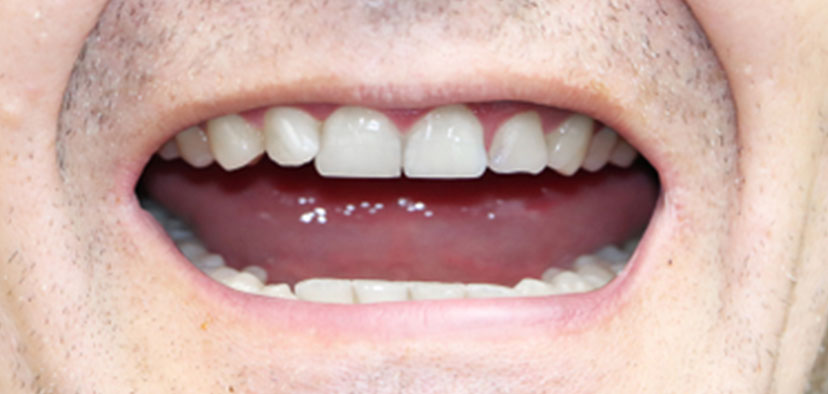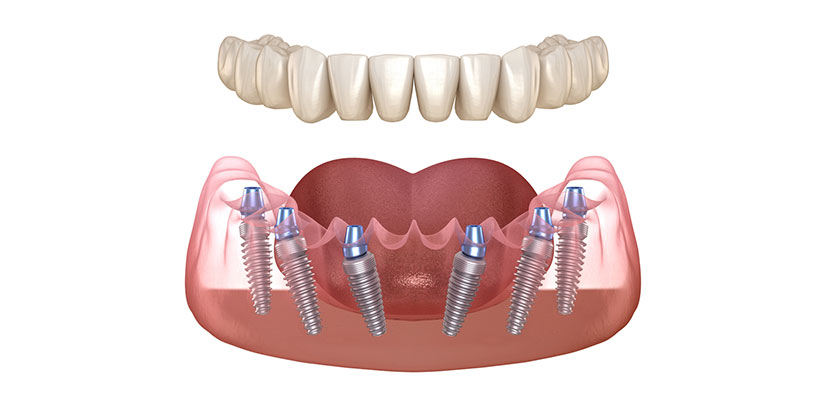Dental Implants in Iran
Affordable Prices And High Quality
Dental implants are the best and newest way to replace missing teeth. Implanted teeth are natural, beautiful, radiant and strong.
Overview of Dental Implant Installation in Iran


Implants in Iran, compared to dentures and dental bridges, are a very good choice for those who have lost one or more teeth. In short, an implant is a basic mount that is surgically placed inside the jawbone and later a dental prosthesis is mounted on it. Today implants in Iran and other countries have become the main treatment for lost teeth. Wherever you are in the world, you can use Medpaltrip services to perform dental implants at affordable prices, very high quality and at world class standards in Iran.
In this article, we are going to talk about dental implants providing information such as their costs in Iran, complications, Same-Day Dental Implants and pre- and post-implant care. We will also fully cover the method of implant placement in Iran.
Cost of Implants in Iran
Similar to countless other surgeries, implant services in Iran compete with most Western and Asian countries in terms of price and quality; that is to say that the cost of one dental implant in the world would pay for multiple implants in Iran with the same quality.
Iranian dentists are among the most specialized in the world. The majority of them have graduated in European countries, America or from prestigious universities in Iran, are vastly experienced and have pioneered in their own styles of treatment in this field.
Only the highest quality of dental implants are used in Iran. The components and compounds used in these implants are often made in countries such as the United States, Germany, Switzerland and Korea. Additionally, Iranian dental clinics have international standards and are equipped with advanced facilities.
Take a look at the charts below to compare dental implant prices (per unit) in Iran with the rest of the world.

Of course, you should take note that in estimating the price of implants in Iran, various factors are involved, including the following:
- Shape and material of the implant;
- Country of manufacture of implants;
- Quality of the local bone, the need or otherwise, for bone grafting and other treatments;
- Implant procedures and time required for it.
To perform implants in Iran, you can use the travel, accommodation and treatment packages available in Medpaltrip.
Procedure Details
The time necessary for installing dental implants varies from case to case. The entire process is carried out under local anesthesia, does not require clinical stay and the healing take a maximum of 1 week. The candidate will have to stay in Iran for 7 days and can return to work a week after the procedure.
Anesthesia
Local
Operation
Variable
Clinical Stay
Not Required
Total Stay
7 Days
Back to Work
7 Days
Healing
1 – 7 Days
What Is The Use of Implants?

Losing a tooth for whatever reason, can have various complications including:
- Negatively affecting the smile, general beauty of the face and self-esteem;
- Make chewing difficult and threaten general health;
- In some cases, the person’s speech is impaired;
- The surrounding teeth may move towards the toothless area, in which case the order of the teeth and the shape of the jaw will be disturbed;
- The jawbone decays in the toothless area;
- If all of a person’s teeth are lost, the long-term attachment of the muscles to the bone will be reduced and the facial muscles will sag.
To prevent this from happening, one’s tooth must be replaced. Lost teeth are replaced with the following methods:
Removable denture
A prosthetic, removable set of artificial teeth that is mounted on the gums
Multi-unit veneers
These veneers are also known as dental bridges. Dental bridges are actually several interlocking veneers or prostheses that are placed on the crown of adjacent teeth to replace a lost tooth.
Dental Implant
The implantation of one or more artificial teeth in the jaw, which is described in detail below.
What Is A Dental Implant?

Before explaining implants in Iran, it is better to know what implants are. The term “Implant” generally refers to “inserting or fixing a tissue or an artificial object in a person’s body“; in this method, artificial teeth are implanted inside the jaw with a firm screw.
The components of a dental implant consist of three main parts:
- The Fixature: A very strong screw that is implanted inside the jaw acting as the root of the tooth;
- The Abutment: Attaches the tooth crown to the fixature;
- The Artificial Tooth (Crown): The artificial replica of a natural tooth.
The Fixature
One of the components of a dental implant is its base, also referred to as the “Fixture”, “Post” or “Screw”. This acts as the root of the newly implanted tooth. The Fixture is usually made of titanium metal along with aluminum and vanadium alloys. This metal is strong and is well accepted in the structure of the gums and jaw. Fixers come in a variety of lengths, diameters, and shapes, but the most commonly used type today is cylindrical and serrated.
To place the Fixature, the dental surgeon makes a hole and inserts the Fixture into the jawbone. Then, depending on the type of implantation method (which we will discuss later), a healing abutment or cover screw is carefully set on the Fixture.
- The Cover Screw is a temporary cover that is mounted on the Fixature before the dental surgeon sutures the gum. This prevents blood and infectious microorganisms from entering the Fixature.
- The Healing Abutment is a supporting piece that helps shape the gum while the Fixature is fusing with the jawbone. This piece protrudes from the gums and is therefore visible. The Healing Abutment is usually made of methylene polyoxide, titanium metal or zirconia.
It usually takes 3 to 6 months for the upper jawbone (maxilla) tissue, and 2 to 4 months for the lower jawbone (mandible) tissue to strongly fuse with the Fixature.
The Abutment
Another component of a dental implant is the Abutment also known as the Connector. Since the post or fixture is below the gum line and the denture or crown can not be mounted on it directly, a supporting piece or abutment is used. The abutment is a short screw that is usually mounted on the fixture after a few months when the process of fusing the jawbone with the fixature is done. Of course, sometimes in immediate implants, the abutment is attached to the fixture from the beginning.
The abutments, similar to the fixture, are usually made of titanium. For the very few who may be allergic to titanium, zirconia-based dental implants are used which have ceramic compositions.
With titanium implants, using the abutments, the dentist has the freedom to create appropriate angles relative to further enhance the beauty of the implanted tooth. On the other hand, zirconia implants are made of a single piece and do not have a separate abutment, so they can not be used in other angles. They are also more expensive than titanium implants.
The Dental Prosthesis
This component of the dental implant is the outermost part also commonly referred to as the Crown. The dental prosthesis is mounted on the abutment. Depending on the type of implant, the prosthesis may be screwed on, or glued with a special dental adhesive called cement. Dental prostheses are often made up of ceramic compositions.
Various Dental Dentures Compositions
- PMF which stands for Porcelain Fused to Metal is the most common composition of dental dentures. This type of veneer is a compound of metals under a layer of ceramic or porcelain and is very strong.
- Zirconia Veneers: It is less resistant compared to PMF but is more stylish. This type of veneer is only made up of ceramic compositions and is metal-free.
- Full Metal Veneers: This type of veneer is fully metal and is less commonly used.
Durability And Longevity
Depending on the quality of the implant and its dental care, the lifespan of a dental implant is about ten to twenty years. The longevity of dental implants is often affected by various causes such as inflammation of the local tissues and improper attachment of the jawbone with the implant.
Advantages of Implants Over Other Methods
- They look and feel almost identical to natural teeth.
- Their performance is identical to natural teeth and causes no restrictions in eating.
- Unlike removable prosthesis (dentures), they are permanently fixed in the gums and eliminate the need for their removal.
- Sometimes removable dentures lack sufficient grip and may lead to issues when chewing and talking. Dental implants, on the other hand, are permanently attached to the bone like natural teeth.
- Implant placement, unlike multi-unit veneers, does not require adjacent teeth to be machined and eliminates the risk of dental fractures and decay.
- Make natural speech and speaking possible.
- Similar to natural teeth, they can be cleaned by tooth-brushes and dental floss.
- They prevent the jawbone from erosion while other methods do not.
- They are stronger and more resistant (for upto twenty years with proper dental care).
- 98% success rate.
- Do not need annual adjustments or replacement.
- They have very few complications.
Considering all the above mentioned, in most cases, dental implants are the first choice of dentists for replacing lost teeth in Iran.
Advantages Of Installing Dental Implant In Iran
As dental implants gain popularity around the globe, their use in Iran has also increased dramatically. Among the various dental replacement treatments available, dental implants are often the prefered choice as it is more advantageous compared to other methods. This has led to a tremendous rise in both the quality of the implants and the skills of the dentist in providing implant services in Iran. Such services with such high quality are also significantly cheaper in Iran than in other countries. This has turned Iran into a suitable destination for implant treatments.
Applications

- Tooth replacement;
- Replacing multiple teeth when a large area is left toothless;
- Implanting the entire teeth set when the patient is completely toothless.
As shown in the picture below, in such instances, a number of implants are placed in the jaw, a multi-unit veneer or a set of dentures are mounted on them. These are called Overdenture. Removable implant-retained Overdentures are far more advantageous compared to traditional dentures. Some of these pros include preserving the local bone and the constant positioning of the dentures while chewing and talking.
The number of implants in an implant-retained overdenture is less than the number of implant-retained multi-unit veneers and hence cost less.
Who Is It For?
Almost anybody can have an implant but ultimately, the dentist who selects the most suitable treatment considering the necessary clinical examination and medical history of the patient. The use of implants have more complications in the following cases and requires more specialized examination:
- People with uncontrolled diabetes;
- People taking long-term steroid medications such as, patients who have had an organ transplant or have an autoimmune disease;
- People undergoing head and neck radiotherapy;
- Pregnant women;
- People with granulocytopenia (an illness associated with a decrease in the number of white blood cells);
- People with Fibrous Dysplasia;
- People who are accustomed to gnashing their teeth;
- People with bleeding disorders;
- People with osteoporosis;
- Smokers. (Smoking reduces blood flow to the tissues of the implant area and impairs the repair and fusion of the implant base in the jawbone).
Pre-Installation Procedures
- The patient undergoing implant treatment must be over 18 as the procedure requires complete formation of jaw and facial bone;
- If an implant is to replace a damaged tooth, it must usually be several months after the damaged tooth is extracted;
- Tooth decay must be checked and removed before the operation;
- If you plan to have your teeth whitened, it is best to do it before the implant so that the crown color is chosen to match the other whitened teeth;
- The dentist will review your medical history. Be sure to tell your dentist if you have a specific condition such as high blood pressure or diabetes;
- The dentist will then examine the condition of your oral tissue and teeth. Based on the examinations and help of radiographs and other imaging methods, he offers the appropriate treatment plan for your teeth. In this treatment plan, the number of implants required, the type of implant and the diameter of the implant used are specified;
- If the width or height of your bone at the implant site is insufficient, your dentist will use a bone graft. Bone grafting is done before implant placement and in some cases at the same time as implant placement;.If there is any residual root or tooth in the area, it should be removed before implant placement. Your gums may also be inflamed, in which case they must first be removed and then the dentist will replace the implant;
Stages Of Installing Implants In Iran

Local anesthesia is usually used during implant surgery, and in rare cases, full anesthesia is used in well-equipped clinics. Depending on the number of implants and the complexity of the condition, the duration of implant operation varies from one to several hours.
Implants can be placed through a single stage, two stages or immediately:
One-Stage Dental Implant
- In this method, a surgery is carried out. The dentist first drills a hole in the jawbone with a special drill to place the implant (fixature). Once the fixature is in place, the healing abutment is mounted on it.
- In most cases, after 3 to 6 months for the upper jawbone (maxilla) and 2 to 4 months for the lower jawbone (mandible), sufficient bone has formed around the fixture. However, in some cases, more time may be required.
- At this time, the dentist will make a mold of your teeth and implants and send them to the laboratory where a prosthesis suitable for implants is made.
Next, the dentist attaches the abutment and prosthesis to the fixture.
Two-Stage Dental Implant
- This method is usually performed when you have had a bone graft or the quality of the bone in the area is not good. In this case, two surgeries are required.
- During the first surgery, the dentist pierces the bone at the site and places the fixture in that area. At this stage, the implant is placed at the same level as the jawbone and is covered with a screw cover. The gums are then sutured to this area.
- In the second stage, another surgery is performed where the gums are removed and the screw cover is replaced with a healing abutment.
- After two weeks, the dentist molds the teeth and implants to send them to the laboratory.
- After the prosthesis is made in the laboratory, the dentist mounts it to the fixture.
To facilitate implant placement in Iran, you can limit implant placement in Iran, which involves placing a fixture or base in the jaw, and install the dental crown in your home country once the jawbone is properly fused with the screws.
Same-Day Dental Implant
During Same-Day Dental Implant, also known as Immediate Dental Implant, once the tooth is extracted, the fixture is placed inside the jawbone and a temporary crown is mounted to retain beauty. After some time with the dentist’s diagnosis, the temporary crown is replaced with a permanent crown. In this method the patient must have a good bone quality. Immediate dental implants are popular with many clients due to their fast-paced procedure.
Medpaltrip will provide world class dental implant services so you can receive the best treatment possible.
Post-Installation Care In Iran
- Rest for up to two days after surgery and avoid heavy activity.
- On the first night after surgery, brush your teeth with a soft toothbrush.
- You can resume normal brushing 24 hours after surgery, but do not brush the suture area or the implant.
- Use mouthwash for up to two weeks after surgery as directed by your dentist.
- Use painkillers prescribed by your dentist to reduce postoperative pain.
- Antibiotics may also be needed at the dentist’s discretion.
- If you use a denture that applies pressure on the area around the implant, do not use it until two weeks after surgery. Then see your dentist to make changes; This will reduce the pressure on the tissue when using it.
- Oral hygiene plays a key role in increasing the lifespan of the implant and preventing damages. Hence, you should take brushing and flossing very seriously.
- Be sure to see your dentist regularly at the appointed times to check your implants.
Complications
- In the first few days after surgery, pain, bruising of the gums, and numbness of the surgical site is normal.
- Hygiene should be observed when receiving implants and afterwards to eliminate the possibility of infection.
- If the implant is not placed by a specialist dentist, the implant may be loose and not attach to the bone properly. Nerves, arteries, sinuses and other tissues may also be damaged during surgery. Choosing an experienced dentist with sufficient knowledge of the mouth and teeth will help reduce these complications. We can help you with this choice.
- Some may be allergic to the material used for the implant. If you experience symptoms such as facial eczema, swelling, itching, gingival and bone resorption, and fever, see your dentist to identify the cause of the allergy, and if necessary, remove the implant and replace it with a suitable substance.
